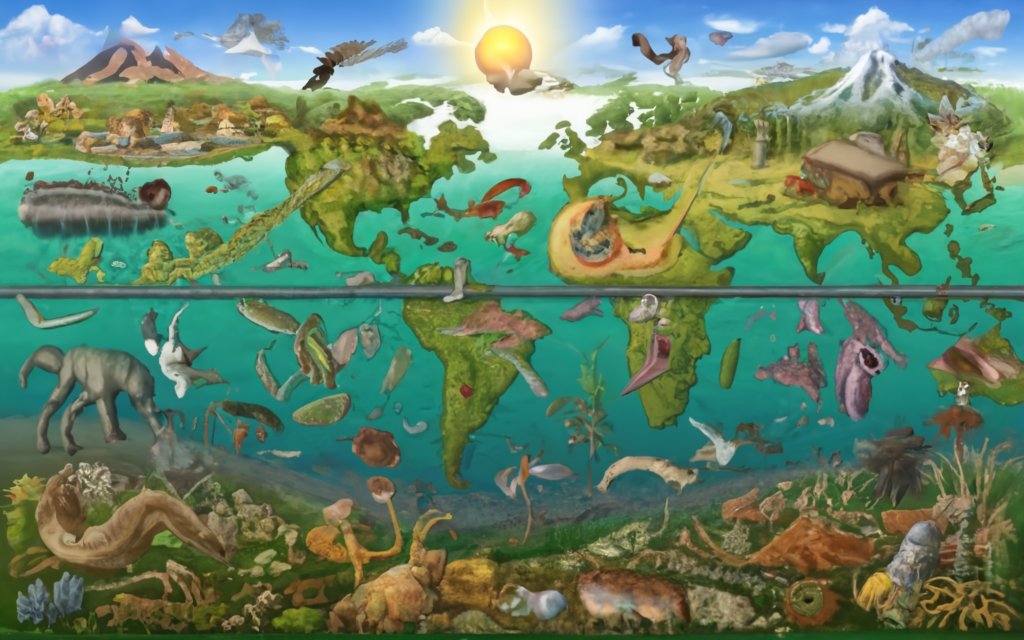Exploring Earth’s Epic Journey: From Microbes to Magnificent Beasts

“Exploring Earth’s Epic Journey: From Microbes to Marvels.” Come explore the fascinating history of our world, from the modest origins of bacteria to the astounding variety of contemporary ecosystems.
Discover the explosive events that shaped life on Earth, the emergence of oxygen, and the revolutionary evolution of cells. Learn the mysteries behind the origin of the earliest organisms and the formation of the hard corals that currently adorn our seas as we go through the Ediacaran Period and the Cambrian Explosion.
A new chapter in Earth’s development is revealed in each segment, highlighting the adaptability, inventiveness, and interdependence of all species. This essay promises to be an interesting and thought-provoking trip through time, regardless of your interests—science, nature, or just general curiosity in the wonders of our world.
Come celebrate the wonders of Earth’s history, learn about the underlying principles of contemporary ecosystems, and treasure the teachings nature has to give. Let this well-optimized essay serve as your roadmap to discovering the mysteries of the amazing voyage of our planet. Set out on this journey right now!
Table of Contents
The Ancient Earth
Oxygen-Free Beginning
Do you recall a period when Earth lacked the oxygen we breathe today and looked more like a science fiction set? Then, it was not an animal-friendly location. Approximately 3.7 billion years ago, microscopic creatures known as microorganisms dominated the landscape and left their mark on rocks.
Oxygen’s Rise
A little over 2.4 billion years ago, cyanobacteria entered the scene. They initiated the Great Oxidation Event by using photosynthesis to produce oxygen. Oxygen-intolerant microorganisms found life difficult as a result of the environment changing and the skyrocketing oxygen levels.
Rollercoaster with Oxygen
Following the oxygen explosion, levels steadied but decreased for a few billion years. In fact, the decomposing cyanobacteria reduced the oxygen even more. Not that oxygen-loving organisms found the ocean to be a comfortable place yet.
The Revolution of Cells
Evolution of Eukaryotes
Microbes aren’t designed for intricacy. Now let’s look at eukaryotic cells, which have unique nuclei and organelles. Cells began to cooperate and coexist for shared advantages such as effective nourishment and defence.
The Mitochondria’s Origin
The energy-processing organelles known as mitochondria were discovered by germs stowing away inside other organisms. Nuclei are the ideal place for DNA to call home. Now, eukaryotic cells were the hippest people on the street.
Group Living
About 800 million years ago, the earliest creatures evolved from cells that supported one another. With their basic yet functional body design, sponges were the first organisms on Earth to create reefs.
Ediacaran Extravaganza
A Variety of Undersea Life
The Ediacaran Period, which began around 580 million years ago, included a variety of benthic animals coexisting with sponges. Fossil evidence suggests organisms whose bodies resembled quilts, ribbons, and fronds.
Increased Oxygen
The presence of sponges eating bacteria caused the oxygen levels to rise. However, the majority of Ediacaran species disappeared during the enigmatic End-Ediacaran Extinction about 541 million years ago.
The Cambrian Carnival
Life Explodes
There was a remarkable explosion of new life forms from 541-485 million years ago during the Cambrian Period. The emergence of hard body features like spines and shells allowed animals to modify their surroundings.
A Varied Cast of Characters
Strange animals prowled the area, including trilobites and the eccentric Opabinia. Fossils from the Burgess Shale revealed the untamed richness of Cambrian life. Established animal categories or phyla evolved when changes were place.
Unveiling Earth's Evolutionary Masterpiece
Every chapter in the epic story of Earth’s evolution—from microorganisms to majestic beasts—brings with it new characters and difficulties. Evolution has always been a narrative of change and adaptation on our planet, from the common cyanobacteria to the exotic Opabinia.
It’s important to acknowledge the complex road that got us here even as we wonder at the diversity of life that surrounds us now. Scientists like Drs. Klaus Ruetzler and Douglas Erwin use fossils and other historical artefacts as a reference to solve the planet’s long-standing riddles.
So keep in mind the amazing trip our planet has undergone the next time you gaze at the ocean or discover the beauty of nature. Earth’s tale is one of tenacity, ingenuity, and the never-ending dance of life, from oxygen-starved origins to the thriving ecosystems we treasure.
FAQs: Revealing the Secrets of Earth
What effects did oxygen levels have on Earth’s early life?
Elevations of oxygen were crucial in forming Earth’s ecosystems. The evolution and survival of many living forms were significantly impacted by the increase and stabilisation of oxygen.
What caused the Ediacaran organisms to decline?
The causes of the End-Ediacaran Extinction are still unknown, however possible causes include changing environmental conditions, feeding interactions, and developing animal body designs.
Why did Earth’s history depend so heavily on the Cambrian Period?
The creation of main animal kinds or phyla that serve as the basis for today’s ecosystems was made possible by the rapid evolution of life forms known as the Cambrian Explosion.
What role did sponges play in maintaining Earth’s oxygen levels?
Because of the way they fed, sponges helped to increase oxygen levels by eating microorganisms. A variety of elements interacted to shape the Ediacaran period’s dominant environmental conditions.
What do the fossils from the Burgess Shale tell us about life in the past?
The fossils from the Burgess Shale give a unique view of the many and unusual living forms that were prevalent during the Cambrian Period, providing important information about Earth’s evolutionary past.